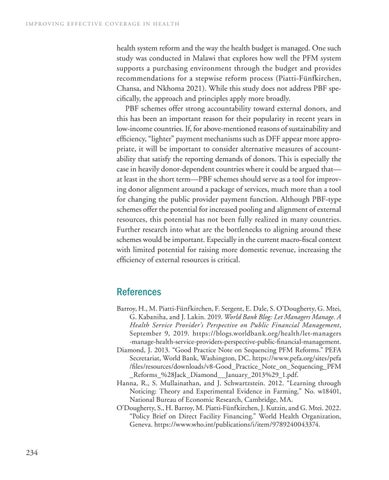IMPROVING EFFECTIVE COVERAGE IN HEALTH
health system reform and the way the health budget is managed. One such study was conducted in Malawi that explores how well the PFM system supports a purchasing environment through the budget and provides recommendations for a stepwise reform process (Piatti-Fünfkirchen, Chansa, and Nkhoma 2021). While this study does not address PBF specifically, the approach and principles apply more broadly. PBF schemes offer strong accountability toward external donors, and this has been an important reason for their popularity in recent years in low-income countries. If, for above-mentioned reasons of sustainability and efficiency, “lighter” payment mechanisms such as DFF appear more appropriate, it will be important to consider alternative measures of accountability that satisfy the reporting demands of donors. This is especially the case in heavily donor-dependent countries where it could be argued that— at least in the short term—PBF schemes should serve as a tool for improving donor alignment around a package of services, much more than a tool for changing the public provider payment function. Although PBF-type schemes offer the potential for increased pooling and alignment of external resources, this potential has not been fully realized in many countries. Further research into what are the bottlenecks to aligning around these schemes would be important. Especially in the current macro-fiscal context with limited potential for raising more domestic revenue, increasing the efficiency of external resources is critical.
References Barroy, H., M. Piatti-Fünfkirchen, F. Sergent, E. Dale, S. O’Dougherty, G. Mtei, G. Kabaniha, and J. Lakin. 2019. World Bank Blog: Let Managers Manage. A Health Service Provider’s Perspective on Public Financial Management, September 9, 2019. https://blogs.worldbank.org/health/let-managers -manage-health-service-providers-perspective-public-financial-management. Diamond, J. 2013. “Good Practice Note on Sequencing PFM Reforms.” PEFA Secretariat, World Bank, Washington, DC. https://www.pefa.org/sites/pefa /files/resources/downloads/v8-Good_Practice_Note_on_Sequencing_PFM _Reforms_%28Jack_Diamond__January_2013%29_1.pdf. Hanna, R., S. Mullainathan, and J. Schwartzstein. 2012. “Learning through Noticing: Theory and Experimental Evidence in Farming.” No. w18401, National Bureau of Economic Research, Cambridge, MA. O’Dougherty, S., H. Barroy, M. Piatti-Fünfkirchen, J. Kutzin, and G. Mtei. 2022. “Policy Brief on Direct Facility Financing.” World Health Organization, Geneva. https://www.who.int/publications/i/item/9789240043374.
234

